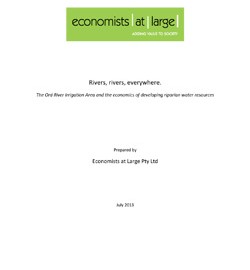The Wilderness Society has commissioned Economists at Large to conduct a literature review on the economics of developing northern Australia’s riparian water resources.
In particular, this report will look at the Ord River Irrigation Area. Located predominantly in the East Kimberley region of Western Australia, although planned land releases will extend the area into the Northern Territory.
Despite the long history of calls to develop a northern ‘food bowl’ there has been little detailed economic analysis into the benefits and costs of doing so.
Developing northern Australia’s riparian water resources has historically required significant amounts of public investment. Future expansion is likely to be no different. Were this not the case, it is likely that the private sector would have already invested.
There is a serious need for extensive economic analysis into the viability of irrigation projects prior to project construction, as well as economic evaluations post completion. This is something that has been noticeably lacking in available literature, although it is by no means a recent phenomenon. The economist Bruce Robinson Davidson wrote extensively on the economics of the Ord River Irrigation Area and found that in most cases, politics trumped economics. Many of the motives discussed by Davidson and his rebuttals to these motives are as relevant today as they were when he wrote them over 40 years ago.
At a state level, Western Australia has a suite of policies, the Strategic Asset Management Framework (SAMF), designed to assist with decisions regarding major infrastructure investment. An inquiry into the Ord-East Kimberley Expansion project found that the SAMF had not been used to assess the project.
The experience of the Ord River Irrigation Area suggests that rather than following an established process for analysis, things are often muddled. Beginning first with a plan for infrastructure based on broad economic assumptions about the region and often failing to adequately assess the economic potential of various crops.
The most recent comprehensive benefit-cost analysis of the Ord River Irrigation Area was released in 1993. This analysis, by consultants Hassall & Associates showed that between 1958 and 1991 the government had invested $613 million into the scheme to extract benefits of just $102 million. In other words, for every $1 invested in the ORIA, the public has received back just 17 cents.
To put this into perspective, had the government invested the amount it spent up until 1972 on public works in an interest-bearing asset earning just 2.5% annually, it would have had over $600 million in the bank by 1992[1], rather than a $511 million loss.
Hassall & Associates also forecasted future benefits and costs for the Ord River Irrigation Area out to 2021.
In recent years, an additional $379.50 million of capital expenditure has been committed to the Ord River Irrigation Area as part of the Ord Final Agreement in 2005 and the Ord Irrigation Expansion Plan in 2009.
An update of the Hassall & Associates analysis could have been undertaken at relatively low-cost to gain a truer picture of the ORIA in 2009 based on empirical data about actual production levels and government expenditure.
Adjusting known costs to 2012 dollars, we can conservatively estimate that around $1.45 billion has been spent on the Ord River Irrigation Project to date. This does not include any farming related infrastructure investment as part of the Federally funded Ord East Kimberley Development Package. Against these costs, we have known benefits of $14 million in 1991, adjusted to $24 million in 2012 dollars. This ignores any profits made between 1991 and 2012 and these would need to be considered to estimate the net costs of the ORIA. Similarly, the current round of investment is presupposed upon future profits being earned by whoever develops the new areas of land available.
More detailed analysis of costs and benefits would have been invaluable to the public debate about the benefits of further investment in the ORIA. The work of Hassall and Associates provides a template against which empirical data could have been entered and it is disappointing that the ex-ante analysis wasn’t updated prior to new investment in the Ord.
Over 40 years ago, the economist Bruce Davidson discussed the importance of asking some basic questions about developing northern Australia. These questions remain as valid as ever, especially in light of our analysis of the Ord River Irrigation Area.
Recent years have shown that small volume, high margin fruit, vegetables and niche products may be viable within the ORIA, though the region remains broadly reliant on tacit government support, as shown by recent government investment in the Ord Irrigation Expansion Project.
There is little doubt that the Ord River Irrigation Area has benefited people in the immediate region. Though this simply reflects a shifting of resources and not necessarily an increase in the size of the pie. Analysis of farm returns rather than gross value of production is essential if we are to understand the true viability of agricultural industries.
With renewed calls to develop northern Australia and the release of the socio-economic component of the Flinders and Gilbert Agricultural Resource Assessment due late 2013, we believe these issues are as important to understand as ever.
[1]Calculated based on $376.8 million in public capital costs up until 1971/72, compounding at 2.5% annually over 20 years.

